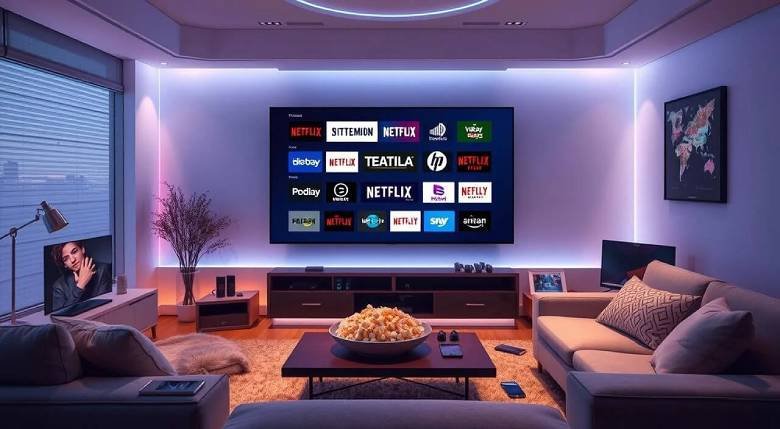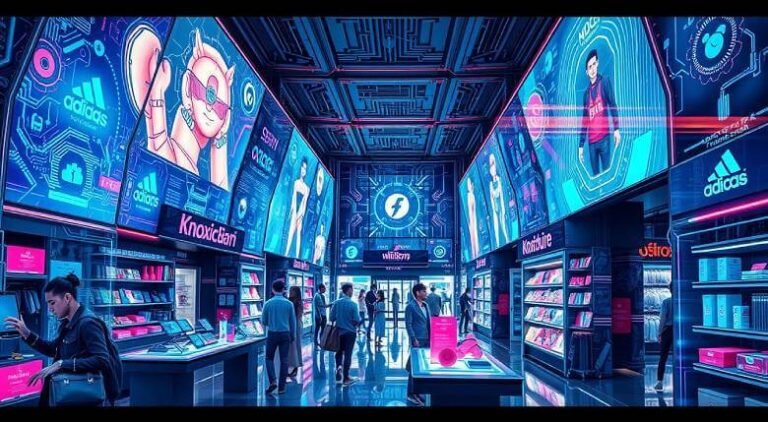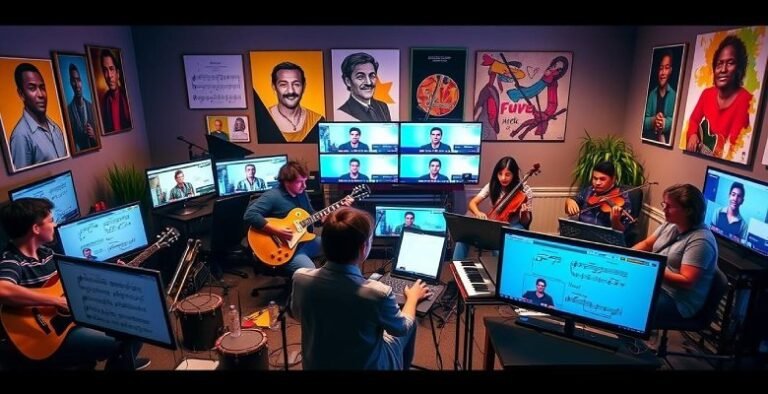The Revolution of Streaming Services in the Entertainment Industry
Introduction The Revolution of Streaming Services in the Entertainment Industry
Did you know that by June 2020, only 14% of adults preferred watching a movie in a theater? On the other hand, 36% chose streaming. This change has made streaming services the main players in entertainment. They offer convenience, a wide range of choices, and creative freedom.
The streaming market is booming, with 85% of American households having a subscription. The average Netflix subscription is $6.99, cheaper than a movie ticket. The growth of smart devices has also helped streaming services reach more people.
Streaming has greatly influenced culture and entertainment. Netflix alone has produced over 6,000 original titles. This includes documentaries and interactive specials. The competition from services like Amazon Prime Video, Hulu, and Disney+ has pushed for better technology. Now, you can stream in 4K and HDR.
Key Takeaways
- The shift to streaming has changed the way you consume entertainment, with 36% of adults preferring to stream movies.
- Streaming services offer a cost-effective alternative to traditional movie tickets, with the average monthly Netflix subscription being $6.99.
- The global reach of streaming services has expanded significantly, with 85% of American households having at least one subscription.
- Streaming platforms have invested heavily in original content production, with Netflix producing over 6,000 original titles.
- The competition in the streaming market has driven innovation, with advanced technologies like 4K and HDR streaming becoming increasingly available.
- Streaming services have disrupted traditional television, providing a wider range of content tailored to personal preferences via AI algorithms.
The Transformation of Entertainment in the Digital Age
Entertainment has changed a lot in recent years. Online platforms and digital content have become more popular. People want convenience, flexibility, and content that fits their interests.
Traditional cable TV is no longer the only choice. Live streaming has become a favorite for many. This change is because of the demand for new ways to enjoy entertainment.
Streaming services have made it easy to watch a lot of content anytime. Netflix and Hulu offer TV shows and movies. Twitch and YouTube Live provide live entertainment.
Some key statistics show how entertainment has changed:
- The global streaming market was valued at about $50 billion in 2022. It’s expected to grow to over $150 billion by 2028.
- By mid-2023, around 1.5 billion people worldwide used streaming services. This is a 25% increase from 2020.
- In the U.S., the average household subscribes to 4.5 streaming services as of 2023.
More people now prefer watching content on-demand. This is because streaming services offer convenience. They don’t follow a traditional TV schedule.
From Cable TV to On-Demand Viewing
The move from cable TV to on-demand viewing is big. Many choose streaming services for their flexibility and convenience. This trend is expected to keep growing.
The Rise of Digital Platforms
Digital platforms are key in the entertainment world. They offer a wide range of content and interactive experiences. They’ve also made live streaming and virtual events popular.
How Consumer Behavior Has Changed
Consumer behavior has changed a lot. People now prefer watching content on-demand. This is because streaming services are convenient and offer a lot of choices.
| Year | Number of Streaming Services | Growth Rate |
|---|---|---|
| 2020 | 1 billion | 10% |
| 2022 | 1.5 billion | 25% |
| 2028 | 2.5 billion | 50% |
How Streaming Services Are Reshaping Pop Culture
Streaming services have changed how we watch multimedia entertainment. Now, we can access content from over 190 countries instantly. This change has brought new voices and views into pop culture. It has also made it easier for creators and viewers to connect.
Some trends in streaming include:
- Over 60% of global streaming viewers binge-watch shows weekly.
- A 10% rise in TV series with international talent or stories.
- Approximately 70% of users join online fandoms, sharing on social media.
Platforms like Netflix are seeing more content from independent filmmakers. This shows how storytelling is becoming more open. Viral moments, like the “Wednesday Addams dance,” have gotten millions of views quickly.
Streaming services are deeply changing pop culture. They are altering how we enjoy and talk about multimedia entertainment. With more exclusive content, they are key to our entertainment world.
The Impact of Digital Content on Traditional Media
As you explore the changing world of entertainment, it’s key to see how digital content affects traditional media. Streaming services have grown, leading to fewer people watching TV. Now, 56% of Americans prefer streaming over traditional TV.
This change has brought new ways to fund ads, as old methods lose money. The way we watch entertainment is changing fast, with virtual events and live streaming gaining fans. Live streaming is set to grow by 28.5% each year until 2026.
- 80% of consumers prefer on-demand content over traditional linear broadcasts
- 70% of US households subscribed to at least one streaming service in 2022
- Digital ad spending is projected to surpass $200 billion, reflecting a growing shift from traditional advertising methods
Digital content has also changed how ads are made. Now, ads are more personal and subscriptions come in different levels. Looking ahead, virtual events, live streaming, and streaming services will shape the future of entertainment.
Virtual Events and Live Streaming: The New Normal
The world is adapting to virtual events and live streaming. This change is reshaping the culture of entertainment. Online platforms like Netflix and YouTube are leading this shift. The COVID-19 pandemic has made this trend even more popular, with a huge increase in live stream video watched.
Virtual events and live streaming have many benefits. They make it easier for people to join events from anywhere. They also offer new ways to engage, like virtual breakout rooms. For example, Fortnite hosted a virtual concert with Travis Scott, where fans could show off their avatars.
When planning virtual events, consider a few things:
- Choose the right platform, thinking about industry standards and audience expectations
- Use design principles and collaboration tools during planning
- Be ready for tech issues and have backup plans
Hybrid events, combining in-person and virtual, are becoming more common. This mix offers flexibility and helps avoid cancellations. As the streaming world grows, we’ll see even more creative uses of online platform tech to improve virtual events.
The Future of Multimedia Entertainment
Technology keeps getting better, making multimedia entertainment more exciting. Now, we have lots of digital content, live streaming, and more. People in the US spend almost an hour daily watching videos on social media.
Streaming services have grown a lot. They now make up over a third of all TV watching. Netflix gained 37 million subscribers recently. Apple TV+ has about 25 million subscribers. Cloud gaming is also getting popular, with a 10x increase in searches over five years.
Emerging Trends in Multimedia Entertainment
New trends include short videos, virtual events, and podcasts. The gaming world, with over 3.2 billion gamers, will also shape the future.
Here are some key statistics that highlight the growth of multimedia entertainment:
- TikTok has 1.5 billion monthly active users
- Searches for “TikTok dropshipping” have increased by 8,200% in 5 years
- Approximately 162 million people listen to podcasts at least once per month in the US
- There are over 3 million active podcasts
The future of multimedia entertainment is full of surprises. New tech and ideas will keep coming. We can look forward to even more cool content.
| Platform | Monthly Active Users |
|---|---|
| TikTok | 1.5 billion |
| Netflix | 200 million |
| Apple TV+ | 25 million |
Conclusion: Embracing the Streaming Revolution
The streaming revolution is changing how we enjoy culture fast. With over 300 million streaming platform subscriptions worldwide, digital platforms are leading the way. The market is expected to grow even more, showing the power of streaming.
More than 70% of viewers love binge-watching. Streaming services now make up over 80% of the digital video market. This is a big change from traditional media.
The industry has spent over $100 billion on original content. This shows how much they want to keep viewers. But, theater attendance has dropped by about 25% with the rise of streaming.
Yet, over 50% of U.S. households have at least one streaming service. This means there’s a lot of room for creators and distributors. With 3.6 streaming services per average consumer, the entertainment experience is more personal than ever.
As the industry grows, embracing the streaming revolution is key. By changing with consumer habits, using new tech, and making great content, the magic of stories and shared experiences will live on in our digital world.





